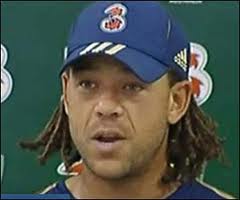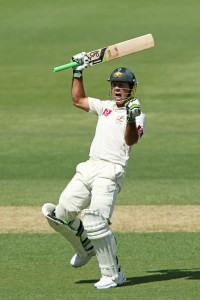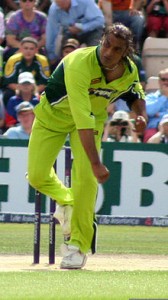Cricket is a sport and for a player to succeed in any sport, he needs to have the 3 Ds – Desire, Dedication and Discipline throughout his career. There have been legendary cricketers over the years such as Sachin Tendulkar, Jacques Kallis, Sir Don Bradman, Imran Khan, Kapil Dev and the list can go on and on who have made a name for themselves in the world of cricket not just because of their talent, but more over their attitude which puts them easily in the ‘Hall of Fame’. However, there have also been many talented cricketers who could have made this list but could not because they either did not take the game seriously or were unable to handle the pressures of modern day cricket. Here are 4 such cricketers who can make it any day to the category of the ‘Bad Boys of Cricket’ –
1) Andrew Flintoff (England)

This man is easily the first to be on this list. Hailing from the county of Lancashire in England, Freddie Flintoff rose quickly through the ranks of domestic cricket. It enabled him to make his Test debut against South Africa at Trent Bridge in 1998. It was not a bright start for him but a wicket of a batsman of Jacques Kallis’ calibre on debut meant that this was a bowler to watch out for in the future. Flintoff was in no time, considered a lucky charm as England won that marquee Test series at home against the Proteas.
But unfortunately the all-rounder could not cement his place in the English team in both Tests and ODIs due to frequent injuries which showed his lack of fitness. That did not seem to improve throughout his career, as he ended up playing only 79 Tests and 141 one day internationals in a span of 11 years. He had his glorious run for the national team after the disastrous Ashes series in Australia in the 2002-03 season since the team management were prompted to bring about several changes in the team and Flintoff was coincidentally 100% fit at the time. Even as he gained huge popularity in the cricketing world for his momentary madness after an ODI match in Mumbai in March 2002 where he removed his England jersey and ran across the ground in celebration of the team leveling the ODI series. A few months, Sourav Ganguly did the same act at Lords after India won the Natwest triangular series final, as a reply to Flintoff that what goes around, comes around. This created a rivalry between Flintoff and other Indian players as well.
In the World Cup 2003 in South Africa, he was the most economical bowler for England in an otherwise horrible campaign for them. Followed by which, he played magnificent cricket for the next three years across the world. His six off South Africa’s pace bowler Makhaya Ntini at the Oval during the fifth Test of the 2003 home series, was one of the longest ones hit over the years and it came right off the middle of the bat. That was the series which began his surge and it followed in 2004, which was even better than 2003.
Against West Indies, he hit his best score of 167 at Edgbaston and regularly clocked between 145-150 km/hr while bowling. His all round brilliance coincided with the team’s turnaround from being the Davids to the Goliaths of Test cricket. In ODI cricket, his exploits helped England make it to the Champions Trophy final at home in September 2004.
But it was 2005 which saw his magnum opus performances in the Ashes series against Australia at home. He suddenly became the toast of the nation, with many hailing him as England’s best ever cricketer. His over at Edgbaston which got the better of Justin Langer and Ricky Ponting, was a dream over for any bowler in the world to bowl in a Test match. His couple of half centuries was a prelude to a stunning and quick fire century at Trent Bridge, which turned out to be not just a match winning one, but a series winning one as well.
From that series ironically, his downfall began. He was made England’s skipper in the absence of Michael Vaughan and did not perform well, even as England leveled a Test series in India. Their ODI performances were dismal throughout the calendar year of 2006 while in Tests, they leveled with a not so strong Sri Lankan team at home. Andrew Strauss was successful when he was captaining England for a brief period of time, but Flintoff begged the English selectors to make him captain again for the heavyweight Ashes series in Australia where England had to defend the urn for the first time since two decades.
It was a very selfish act from him because the team was clearly not inspired by him. All of a sudden, he did not feel like showing his face to the world, let alone play cricket. He was mentally traumatized because the punishing international schedule was taking a toll on his body. When the captain is in such state, what would the team be like? As a result, a 0-5 whitewash was a foregone conclusion. His drinking began on this tour and Duncan Fletcher, the coach wanted to sack him then and there. But fortunately, Michael Vaughan returned from injury to lead the team for the ODIs where they made it to the finals until he suffered another minor injury.
Flintoff had some respite from a traumatic tour as England won both the finals under his leadership against Australia to win the triangular series. But his antics worsened during the biggest stage of them all, the World Cup which was in the Caribbean in 2007. He was found to be so drunk that he had to be picked up from a boat ride and taken back straight to his hotel room in St Lucias. This was a major embarrassment for a resurgent English side, and as a result he was immediately stripped off vice captaincy.
He had a below par World Cup and England were knocked out in the Super 8s stage of the competition. His fitness again became edgy after April 2007 as he could only participate in the home ODIs against India and the T20 World Cup in South Africa. In one of the games against India in the World Cup, he sledged Yuvraj Singh so much so that he got furious and hit 6 sixes off Stuart Broad. That ultimately proved to be the difference between the two sides, even though Flintoff managed to get things right with Yuvraj after the game. It showed his sportsmanship to a certain extent, which was more evident after the Ashes game at Edgbaston in 2005 where he consoled a dejected Brett Lee after Australia’s close loss.
But again Freddie was out of the team, only to return for the second half of 2008. It was a poor season for him and a mixed one for his team. He played his last ODI in April 2009 and his last Test against Australia in the Ashes 2009 at home, in which again he played a crucial one in England winning back the urn with the score line of 2-1. His retirement had to happen and it did, which actually was a blessing in disguise for the team since they wanted to play as a unit and Flintoff’s mere presence would not allow them to.
He tried his luck in the IPL 2009 with Chennai Super Kings but he just does not know how to take care of his body! A sure shot alcoholic that he is, his partying and adventurous lifestyle made him a celebrity in England. But clearly, he has never been in a great frame of mind which was evident in shifting from Manchester to Dubai and then to London, with the reason being that he ‘missed the English sunshine’. More recently, he abused former England skipper Michael Atherton in a newspaper interview for a petty reason that he made judgments on the current team’s players.
Undoubtedly, he will go down as the famous bad boy of cricket perhaps of all time.
2) Andrew Symonds (Australia)

Another Andrew could not live up to his potential. He too is burly, has an impressive height but is not a Flintoff. He is a Symonds. Andrew Symonds could have easily been Australia’s finest all-rounder ever, if it was not for his off the field antics which would frustrate not just his teammates but the entire nation. During his time and even till date to a certain extent, Australia have to live up to the reputation of being world champions, a team which always produced the best quality cricket.
But Symonds tried to enjoy his life more at the expense of his team. In 2005, it was on the tour of England where Australia had a tough time whether it was in the T20s, ODIs or Tests. Symonds was caught being in a drunken state while practicing a day before a match against Bangladesh at Cardiff, which is now famously known for the minnows upsetting the world champions. Ricky Ponting was so furious at him, that he not dropped him for this game but he ensured that he would not be a part of the team for the Ashes series to follow. Symonds had this to do, despite the fact that it was Ponting who pushed for his selection adamantly in the World Cup 2003 winning squad and it was due to him that Symonds could play all the games in the competition and succeed.
He was a pure alcoholic as well, and in 2009 it was ironically in England where another mishap took place. Symonds’ drinking did not go down too well with Ponting this time and as a result, he was sent back home just before the tournament began. Australia went on to be knocked out in the first round of the World T20, but imagine if Symonds was present in the team, it would have been a huge morale booster since he can destroy any bowling attack on his given day and is more than handy with the ball, not to mention that his fielding is outstanding too. But due to that expulsion in 2009, his central contract was taken away by Cricket Australia and that was the indication that everyone had tolerated enough of Symonds.
But in 2008 as well, his dwindling interest in cricket was shown when he skipped a crucial team meeting for going out fishing, before a ODI game against Bangladesh in Darwin. At the beginning of the year, he was primarily involved in one of the ugliest incidents in the game of cricket. He accused Harbhajan Singh of calling him a ‘monkey’ during the New Years Test at Sydney against India. Australia may have won the game, but this incident was a matter of pride for both the countries and the truth prevailing. Eventually, Harbhajan was fined and not suspended which upset Symonds to a huge extent. It cannot be said who was right and who was wrong in this case.
In a radio interview in the 2008-09 season, Symonds was the child of another controversy when he called New Zealand’s explosive opening wicketkeeper batsman Brendon McCullum a ‘lump of s***’ when asked to talk about New South Wales buying him for the T20 competition in Australia. He later went on to reveal how much he loved going to ex teammate and fellow Queenslander Matthew Hayden’s house for dinner often, only to see his wife. Such comments degraded him even further and Cricket Australia appropriately reprimanded him.
He did have support from fellow Aussies such as Ponting and Adam Gilchrist, who made him play often for the Deccan Chargers in the Indian Premier League in the first three seasons. But he could not take full advantage of it and finally quit all forms of cricket in 2012. He became friends with Harbhajan Singh again after playing with him for the Mumbai Indians in the 2011 season, but poor performances could not Bhajji and the team management to retain him in the squad.
Symonds entered the TV show ‘Big Boss’ in India as a guest contestant, where he was taunted by other contestants for being arrogant and stubborn by nature. He left the show in no time, and this was another failure for him. Australia always needed an all-rounder to perfect the balance of their team, and Symonds could have been the experienced and reliable one following the retirements of greats such as Gilchrist, Hayden, McGrath, Gillespie, Langer and Martyn from both Tests and ODIs.
3) Ricky Ponting (Australia)

Believe it or not, but Ponting also falls in this category. He might be remembered in the years to come as the best batsman Australia has ever produced and a two time World Cup winning captain, but all this would have not been possible if he played with the attitude that he possessed at the beginning of his career.
Despite an impressive 95 on Test debut at Perth against Sri Lanka in December 1995 when he was unfortunately given out lbw, Ponting could not be seen regularly in Australia’s ODI and Test teams. This is also after, Geoff Marsh considered him to be the finest teen batsman he had ever seen in Australia. Ponting would get frustrated and as a result, hardly practice his batting hoping that fortune would favour him at some point of time and he would play for his country more often.
In 1998, Australia toured India for a 3 match Test series and a triangular series which also included Zimbabwe. During the second Test in Kolkata, some of the Australian players went out to a nightclub in order to rejuvenate and get ready for playing. Ponting was one of them but he was accused of misbehaving with some women there, because he was completely drunk. And as a result, he was thrown out of the nightclub by the security guards within two hours of his entering.
Ponting maintains that he had a scuffle with one of the security guards but he did not misbehave with any woman, since he was busy celebrating North Melbourne’s win in the national football competition. A couple of months later and he was struggling with his batting form. During the traditional triangular series at home after the New Years, Ponting was involved in not just a minor scuffle, but a major fight with an unidentified man outside a pub in New South Wales. To prove it, he sustained a black eye in the fight and had to speak about it in a press conference which was to be shown on national television.
A humiliated and sorry Ponting admitted then that he was an alcoholic and needed guidance to resurrect his career. But what set Ponting apart from the rest of the crop of the bad boys, was that the incident woke him and made him realize that if he was to make it big in the game of cricket, he had to change his attitude off the field. He eventually managed to discipline himself so much so that he was made the captain of Australia for the first time in March 2002 in ODIs and in March 2004 in Test matches. Under his leadership, Australia remained No.1 in Tests and ODIs winning almost anywhere in the world and being extremely dominant at home. He will maintain the record probably for winning the most number of ODIs and Tests as captain of a national side as well as winning 100 Test matches as an individual.
He might cross the line with his behavior on the field at times, but that is only due to his competitiveness and desire to only make his country win. Batting wise, today Ponting is the second highest run getter and century maker of all time in both Tests and ODIs, being only behind the Master Blaster Sachin Tendulkar. Who would have ever thought that an angry and brash Ponting would become the reliable and respected Ponting today? No one perhaps, no one.
4) Shoaib Akhtar (Pakistan)

He is known as the ‘Rawalpindi Express’ to the cricketing world, and he could have made Pakistan the world champions again. But he could not, and he has no one but himself to blame. Shoaib Akhtar came from a modest background, which kept him grounded while he was making a career for himself to play in Pakistani colours. He made his debut at the age of 22, and he almost instantly became a star in the cricketing world by picking up the wickets of Rahul Dravid and Sachin Tendulkar off consecutive deliveries, and that too clean bowled in the first innings of the Asian Test Championship match at the Eden Gardens in Kolkata in February 1999.
Akhtar then proceeded to prove why he was one of the rising stars of Pakistan cricket, in what was an extremely successful 1999 World Cup in England for him and his team, which made it to the final only to lose against Australia. But then inconsistent performances began to pull him down, at the time when he could have cemented his spot easily as being the first change pacer for Pakistan, with Wasim Akram and Waqar Younis leading the attack. With Waqar, he had an alleged verbal conflict after Pakistan’s first round exit from the 2003 World Cup in South Africa which occurred due to their famous defeat to India, because Sachin Tendulkar took Shoaib on from the word go and smashed him for 18 runs in the second over of the game. Although Shoaib got the better of Sachin eventually, that could not stop India from gaining a convincing win.
He also criticized former Pakistani greats in an interview, which did not go down well with many. And after four months of the World Cup, he infamously became the second bowler in the history of ODI cricket to be charged off ball tampering. He was banned again, a year after he abused one of the Zimbabwean players on the tour of Zimbabwe. But he did not learn from that lesson, as he was banned for one ODI and two Tests for abusing South Africa’s Paul Adams in the home series of 2003.
Following Pakistan’s loss to India in a Test series at home in March 2004, Shoaib’s commitment to playing for the country was finally questioned big time. His relationship with the then captain Inzamam ul Haq and coach Bob Woolmer deteriorated to a huge extent. He began 2005 as well on a bad note as he was sent home by the team management from the crucial tour of Australia, the reason being his disrespectful attitude and indiscipline more than his hamstring injury. His fitness and attitude has always been at the lowest levels and he should have never been picked for Pakistan since. But then again, if he had a terrific day, he was a potential match winner for Pakistan. He made a blink of the eye return against England in a Test series at home and starred in the team’s win, which made his relationship with the captain and coach slightly better.
But he invited misfortune yet again for himself. After undergoing surgery in February 2006, he attempted to make another return for Pakistan only to be accused of taking performance enhancing drugs alongside Mohammad Asif in the ICC Champions Trophy 2006 in India. Since they were illegal to be used, Shoaib was subsequently banned for two years, only to have cleared the ban in court. His use of drugs tarnished his reputation to even greater heights, even as it was already known that he was a playboy and a party animal, who would not mind having a fun night to satisfy his pleasures or sit in a fashion show a day before a match.
Shoaib may have bowled the fastest ball in international cricket till date, but he never bothered about his fitness and thus pace actually destroyed his career. He could have modified his bowling action and focused on developing more variations to be more effective for Pakistan and prolonging his career. But he chose not to, and paid the price for it to a massive extent. He made a return for the inaugural World T20 2007 in South Africa, in which he could have actually won Pakistan the tournament. However, he was sent home after a fight with Mohammad Asif in the dressing room during which he injured him on his left thigh. Shoaib’s ego was mainly responsible for this, as he had to pay a massive 300,000 rupees fine to the Pakistan Cricket Board on the basis of indiscipline.
He tried his hand in the IPL for the Kolkata Knight Riders in 2008, but could not play more than a handful of matches since the governing council banned him for violating the players’ code of conduct. Akhtar did not play much of cricket in 2008 and 2009, as injuries continued to plague him. Yet, he thought that his career was not over and decided to change his attitude to a certain extent.
He did so in the 2010-11 season, which was his final in international cricket. He had quit Tests, which meant that he was available only for ODIs and T20s for Pakistan. His bowling form was much better and he consistently appeared for many matches, in the absence of strike bowlers such as Asif and Mohammad Amir, both who were banned from international cricket for spot fixing on the fateful tour of England in 2010.
But age had finally caught Shoaib off guard, and thus to develop a potential Pakistani pace attack for the future, he was left with no option but to quit international cricket after the World Cup 2011 in the Indian subcontinent. It was too late for the entertainer of the masses to be considered a legend the game has produced. He made batsmen like Ricky Ponting and Sachin Tendulkar struggle to quite an extent, but he was never a troublesome force because he would rarely turn out for Pakistan in Test cricket, and hardly played enough ODIS and T20s because of his continuous injuries. Thus, Shoaib’s career is an important lesson for aspiring youngsters as to how temperament and not as much of skill is required to succeed in the game.

Leave a Reply